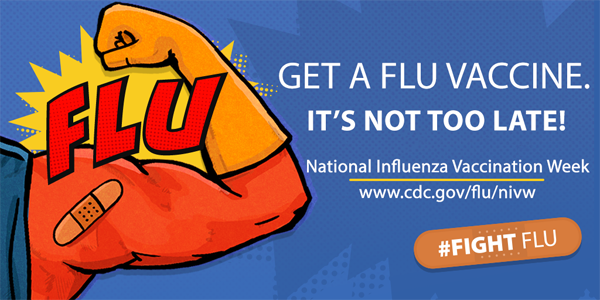This week the public health community celebrates National Influenza Vaccination Week (NIVW), an annual call to action, reminding everyone six months and older that there is still time to get vaccinated against the flu. The importance of the flu vaccine cannot be understated. A recent analysis from the Centers for Disease Control and Prevention (CDC) estimates that in the past decade (2010-2020), the annual incidence of illness due to flu ranged from 9 million – 41 million, hospitalizations ranged from 140,000-710,000, and deaths ranged from 12,000 to 52,000 each year.1 Preliminary burden estimates from the current flu season (2023-2024) show increasing flu activity across the country and lagging rates of vaccination, further underscoring the importance of NIVW this year.2
Nationally, influenza vaccination coverage among adults was trending upward but saw a decline in the 2022-2023 flu season with a coverage rate of 46.9% among individuals 18 years and older compared to 49.4% the previous season (2021-2022).3 Unfortunately, declines in adult flu vaccination coverage remain a trend this current flu season (2023-2024) with coverage being 3 percentage points lower this October compared to October 2022.4 Additionally, racial and ethnic disparities in flu vaccination coverage continue to exist.4, 5 Historically, adults from racial and ethnic minority groups have had lower flu vaccination rates and higher rates of severe flu illness and flu-related outcomes (i.e., hospitalization and death) compared to non-Hispanic White adults.5 The same trend is true for COVID-19.6 Furthermore, Respiratory Syncytial Virus (RSV) remains a threat to the aging population as well.7 Therefore, for this NIVW we must not only continue to acknowledge long-standing disparities but acknowledge the simultaneous threat of influenza, COVID-19, and RSV. We must work together to leverage and enhance strategies that further protect our adult communities from these respiratory viruses through vaccination.8
Local health departments (LHDs) play a significant role in identifying and reducing flu and COVID-19 vaccination inequities by addressing the underlying causes of vaccine access, acceptance, and confidence.6 The CDC continues to support the work of LHDs to improve flu and COVID-19 vaccination coverage among racial and ethnic minority adults through the Partnering for Vaccine Equity (PAVE) project. NACCHO serves as a proud partner in this effort by providing training and technical assistance to selected local jurisdictions funded, to identify and address inequities in adult vaccination with a focus on influenza and COVID-19 vaccine coverage.
Using lessons learned and best practices from LHDs across the nation, we have the opportunity to improve flu and COVID-19 vaccine coverage among racial and ethnic minority adults. To highlight, Boston Public Health Commission (BPHC), located in Massachusetts, created a series of flu and COVID-19 materials (i.e., advertisements, infographics, and fact sheets) across multiple platforms and languages to increase community confidence and education about vaccine safety, efficacy, and importance.
Furthermore, the Emergency Health Services Federation (EHSF), located in Pennsylvania, partnered with the South Central Pennsylvania Immunization Coalition and the South Central Medical Reserve Corps to understand adult vaccine hesitancy. In tandem with COVID-19, EHSF developed a vaccine survey to gather data to understand vaccine hesitancy and acceptance within their rural and migrant communities to inform vaccine outreach and strategies to increase uptake.
The strategies shared highlight a few of several successful strategies health departments across the nation are implementing to reduce vaccine inequities and improve vaccine coverage for influenza and COVID-19. The strategies shared inform ways in which LHDs can continue and increase flu and COVID-19 vaccination coverage among racial and ethnic minority groups.
Join us in observing NIVW and reminding individuals that it is not too late to vaccinate! Use the below strategies and resources to increase flu vaccine uptake in your community.
Strategies to enhance flu vaccination coverage.9, 10, 11, 12, 13
- Offer flu vaccination in convenient places, including the workplace and schools
- Provide incentives for vaccination (gift cards, paid time off for vaccination/recovery, etc.)
- Conduct outreach, including reminder/recall strategies
- Utilize vaccine ambassadors and trusted community leaders to promote the value of vaccination
- Co-administer flu vaccines with other vaccines the patient may be due for, including COVID-19
- Provide vaccination for all age groups whenever available
- Improve flu data quality to identify gaps and better target outreach
Resources
- National Influenza Vaccination Week | CDC
- NIVW Digital Media Toolkit | CDC
- NACCHO Influenza Webpage
- Flu Disparities Among Racial and Ethnic Minority Groups | CDC
- Partnering for Vaccine Equity (PAVE) | CDC
- How Influenza (Flu) Vaccines Are Made | CDC
- Similarities and Differences between Flu and COVID-19 | CDC
- Getting Flu, COVID-19, and RSV Vaccines at the Same Time | CDC
Sources
- Disease Burden of Flu| CDC
- 2023-2024 U.S. Flu Season: Preliminary In-Season Burden Estimates | CDC
- Flu Vaccination Coverage, United States, 2022–23 Influenza Season | FluVaxView | Seasonal Influenza (Flu) | CDC
- Flu Activity Increases While Vaccination Lags | CDC
- Health Equity and Flu| Seasonal Influenza (Flu) | CDC
- CDC Program Engages Partners to Promote Vaccine Equity Among Racial and Ethnic Minority Groups | CDC
- RSV (Respiratory Syncytial Virus) Immunizations | CDC
- US Health Officials Urge Vaccination Against Flu, COVID-19, and RSV This Fall and Winter (nfid.org)
- Promoting Vaccination in the Workplace | CDC
- Vaccination – The Community Guide | Community Preventative Services Task Force
- Coadministration of COVID-19 vaccines with other vaccines | CDC
- School-Located Influenza Vaccination Toolkit | NACCHO
- Collaboration to Address Influenza Vaccination Among Older Adults | NACCHO
